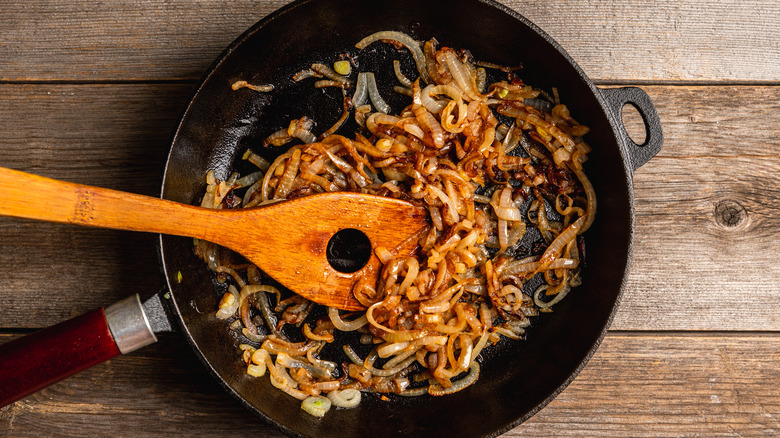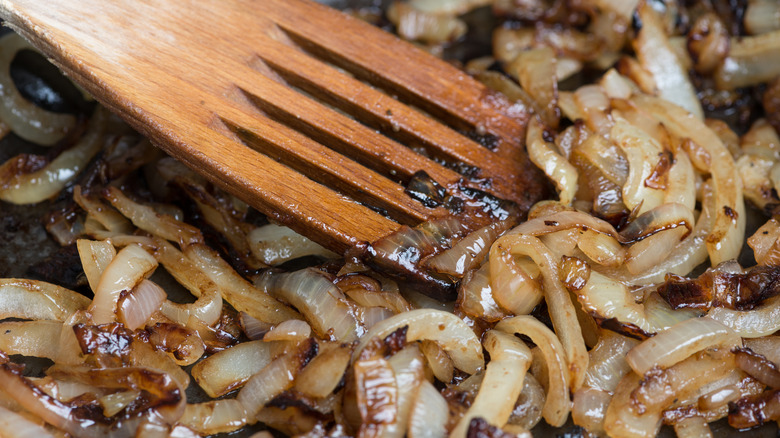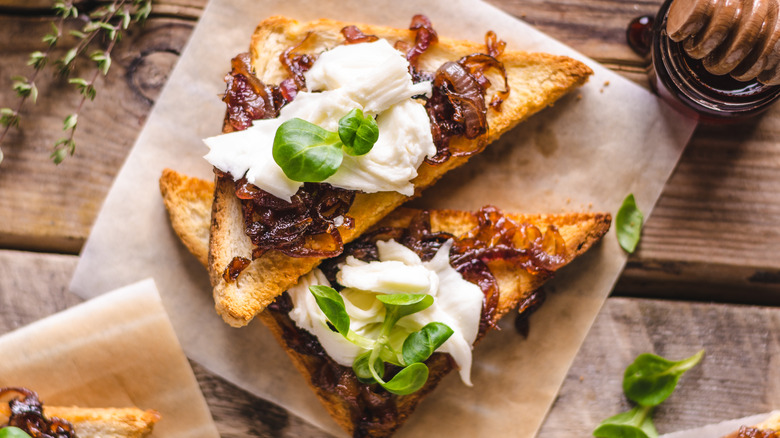The Perfect Amount Of Vinegar For Delicious Caramelized Onions
Caramelized onions are a culinary creation that any home chef can use to instantly elevate any sandwich, burger, or salad — they're even the star ingredient in homemade French onion soup. But to achieve a perfectly sweet flavor and softened texture, cooking down thin slices of onions takes time, a bit of finesse, and the addition of a small amount of what is perhaps an unexpected ingredient: vinegar.
Just a splash of vinegar added in toward the latter end of the onions' cooking process adds a touch of acidity and helps release the sticky, caramelized pieces that can build up at the bottom of the pan. All you need for this method — known as deglazing — is 1 or 2 teaspoons of vinegar for every four onions. Deglazing the pan with vinegar loosens the stuck-on residue (or "fond") at the bottom. Remember not to let these bits build up since they can prevent the onions from cooking evenly and browning fully. For the best taste, these stuck-on bits shouldn't go to waste, as they contain plenty of sweet, caramelized flavor that, when released and stirred back into the onions as they cook, deepens the darkened sugary notes of the whole batch.
Vinegar removes stuck-on bits from the pan
The first step to cooking caramelized onions is letting them soften as they release water and create steam. As they slowly cook, the onions' sugars begin breaking down, creating the beloved caramelized taste. Along with this transformation, the reduced moisture in the pan results in some onions sticking to the bottom.
Deglazing ensures all the caramelized goodness latching onto the pan gets mixed back into the food, adding its flavorful potency. While wine or water can also be used to deglaze a pot roast or other dishes, vinegar's acidity and abrasive nature make it well-suited for caramelizing onions. Adding in small splashes of a relatively neutral-tasting white or white wine vinegar several times throughout the process helps easily scrape up onion bits and results in a subtle acidity.
Some cooks, however, may want to highlight the vinegar's zesty taste by adding it more liberally. For a batch of balsamic caramelized onions, for example, you can add slightly larger amounts of vinegar each time you deglaze the pan for a more pronounced vinegar flavor that compliments the onions' sweetness. Just be careful not to go overboard so the vinegar flavor isn't overpowering. It's also key to avoid adding too much liquid to the pan so the onions can continue caramelizing as they cook down.
Other tips for perfect caramelized onions
The key to evenly cooking caramelized onions is patience, but choosing the right kind of onion is also important. Any type can be caramelized, but sweet yellow onions are particularly suited for the task. Some folks add sugar to the pan to enhance the sweetness, but generally, you can keep things simple and let the onions' natural sugars speak for themselves. Use a large, heavy-bottom pan, such as a stainless steel skillet, with lots of surface area to cook the onions down. Start by melting butter in the pan, then add your sliced onions and let them slowly cook until they caramelize. Begin at medium heat, then lower the temperature as needed to avoid any burnt bits, as these can taste bitter.
Stir the onions with a wooden spoon every five minutes or so, gently scraping the bottom of the pan as needed. Once the steam has evaporated and the onions have become soft and tan in color, stir frequently, scraping the bottom of the pan with a wooden spoon. Check for fond, and when you start seeing stubborn, stuck-on bits, add vinegar in small splashes or drops — just enough to deglaze the pan and harness the fond's flavor. Add a sprinkling of salt or warm spices if desired. The process will take about an hour, but at the end, you'll have onions that are evenly brown and sweetly fragrant.


